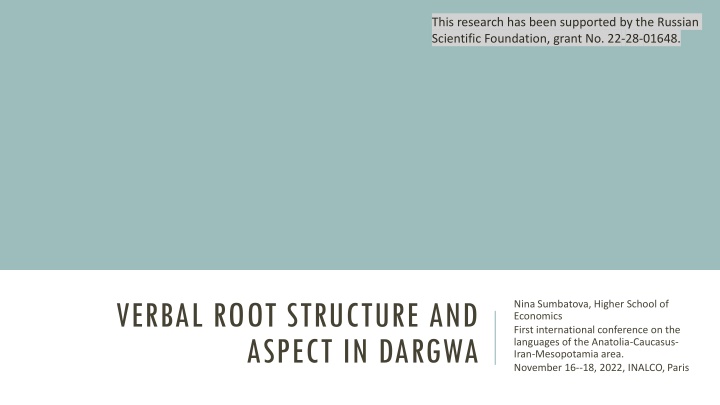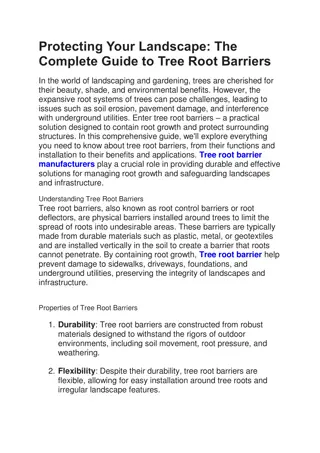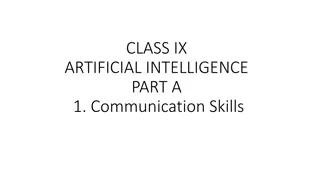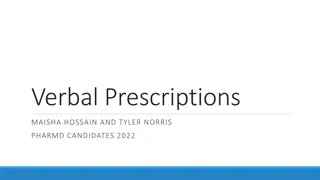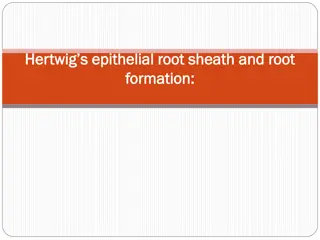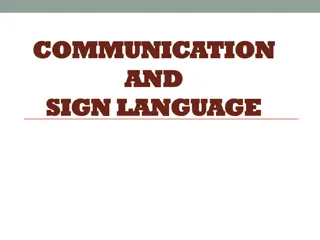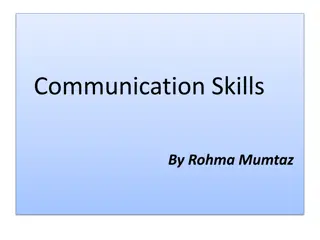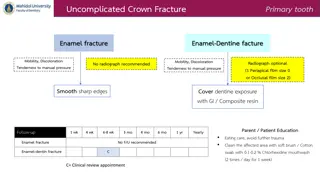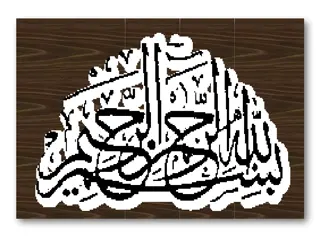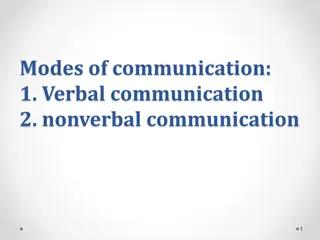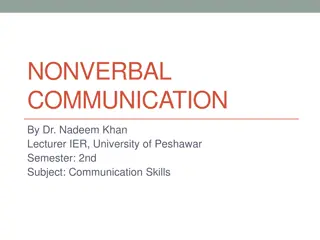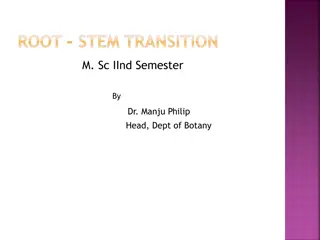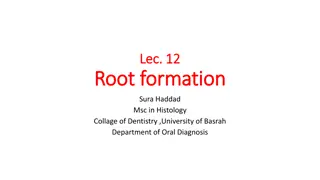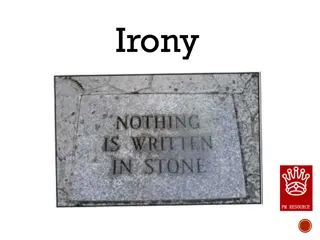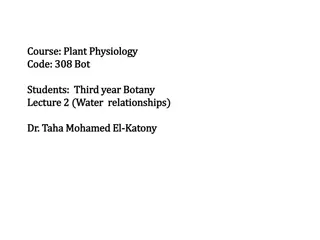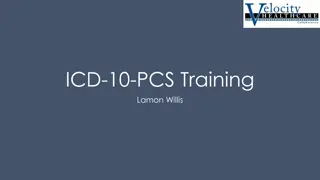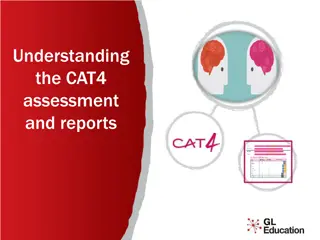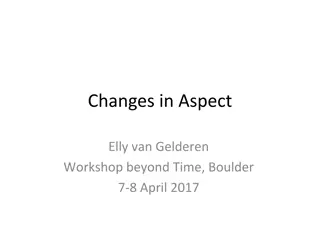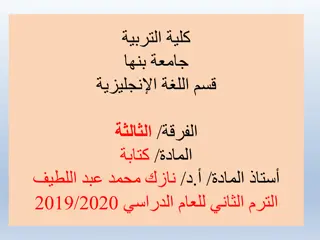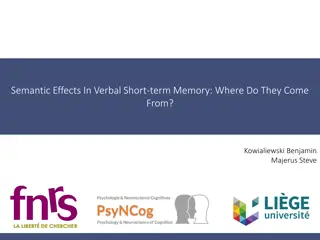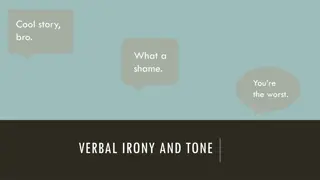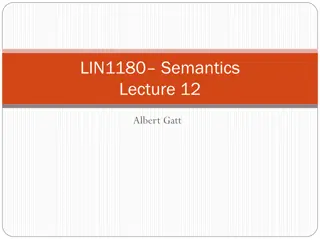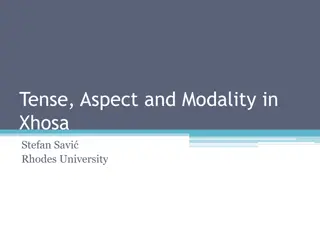VERBAL ROOT STRUCTURE AND ASPECT IN DARGWA
This research, funded by the Russian Scientific Foundation, explores the nuances of verbal root structure and aspect in the Dargwa language. Nina Sumbatova, from the Higher School of Economics, presents findings at the First International Conference on the languages of Anatolia-Caucasus-Iran-Mesopotamia area.
Download Presentation

Please find below an Image/Link to download the presentation.
The content on the website is provided AS IS for your information and personal use only. It may not be sold, licensed, or shared on other websites without obtaining consent from the author.If you encounter any issues during the download, it is possible that the publisher has removed the file from their server.
You are allowed to download the files provided on this website for personal or commercial use, subject to the condition that they are used lawfully. All files are the property of their respective owners.
The content on the website is provided AS IS for your information and personal use only. It may not be sold, licensed, or shared on other websites without obtaining consent from the author.
E N D
Presentation Transcript
This research has been supported by the Russian Scientific Foundation, grant No. 22-28-01648. VERBAL ROOT STRUCTURE AND ASPECT IN DARGWA Nina Sumbatova, Higher School of Economics First international conference on the languages of the Anatolia-Caucasus- Iran-Mesopotamia area. November 16--18, 2022, INALCO, Paris
OUTLINE information on Dargwa genetic, areal and typological info verbal root structure aspect diagnostic suffixes questions and problems database description answers (?)
DARGWA Nakh-Dagestanian (East Caucasian) family approximately 500,000 speakers Central and Eastern part of Dagestan (Russian Federation) well-known for dialectal divergences ergative, left-branching, free word order rich nominal and verbal morphology gender and person agreement 3
DARGWA 4
DARGWA: A LANGUAGE OR A LANGUAGE GROUP? Koryakov 2021: 15 languages and many dialects Diverged in II-III century BC I treat Dargwa as a language group and will discuss the Dargic languages.
SIMPLE AND DERIVED VERBS Root: (GENDER-)ROOT b-ir fall Simple verbs: (GENDER-)ROOT + inflectional affixes b-ir -i fall Derived verbs: + causative suffix + preverb(s) + additional lexical stem b-ir -aq-i drop gu-t i-b-ir -i lose (gu- under + t i- behind ) han-b-ir -i remember (han is a root) (examples from Tanti Dargwa)
VERBAL ROOT STRUCTURE possible root structures: VC, CL-VC VRC, CL-VRC RVC C any consonant, V any vowel, R sonorant : {r, l, m, b, , , w, j} 200-250 verbal roots per language/dialect 7
VERBAL ROOT STRUCTURE: EXAMPLES (MUIRI) Meaning Root: IPFV Infinitive IPFV sew VC ip ip -ara say CL-VC CL-ik' b-ik' -ara throw VRC irh irh -ara find CL-VRC CL-urk: b-urk:-ara write RVC luk luk'-ana
ASPECT Most verbal roots exist in two variants: perfective and imperfective. The opposition of these two variants expresses the category of aspect. This category characterizes verb forms, not whole lexemes. Muiri Dargwa (1) a. b-aq -ib b. b-iq -u-li=sa b i N-hear.PFV-AOR N-hear.IPFV-PRS-CVB=COP N (he) heard (that) (he) hears (that) (2) a. b-aq -ab b. b-iq -ab N-hear.PFV-OPT N-hear.IPFV-OPT let (him) hear (PFV) let (him) hear (IPFV)
ASPECT The two variants of a root show common phonological features but their relationship is highly irregular. Meaning Root: PFV Root: IPFV Infinitive PFV/IPFV find CL-ark: CL-urk: b-ark:-ara/b-urk:-ara write CL-elk' luk b-elk'-ana/luk'-ana throw ih irh ih -ara/irh -ara CL-irq- iq- thresh d-irq-a ra/iq-a ra sew CL-ep ip b-ep -ara/ip -ara sow CL-a CL-al b-a -ana/b-al -ana measure umc umc umc-ara/umc-ara
AORIST MARKERS AND OTHER DIAGNOSTIC SUFFIXES In most languages of the group, verbs fall into three inflectional classes. These classes are manifested in the choice of certain inflectional affixes, first of all the aorist markers. Tanti Dargwa a. b-ar -ib N-find.PFV-AOR (he) found (it) ha-b-iq -ur UP-N-light.PFV-AOR (he) lit (it) up b-el -un N-read.PFV-AOR (he) read (it) b. b-ur -u-le N-find.IPFV-PRS-CVB (he) is finding (it) ha-b-ilq'-u-le UP-N-light.IPFV-PRS-CVB (he) is lighting (it) up b-u -un-ne N-read.IPFV-PRS-CVB (he) is reading (it) c. b-ark -ab N-find.IPFV-PRS-CVB let (him) find ha-b-iq'-ab UP-N-light.IPFV-PRS-CVB let (hin) light up b-el -ab N-read.IPFV-PRS-CVB let (him) read (it)
AORIST MARKERS AS A TRACE OF ROOT DETERMINERS The diagnostic suffixes ( root determiners ) show correlation with the root sonorants (Mudrak 2016: 72 79): VlC-(V)n VrC-(V)r Muiri: arc-ur fly-AOR b-el -un read-AOR
QUESTIONS TO BE DISCUSSED 1. is the structure of cognate verbal root the same in different languages of the Dargwa group? 2. are the vowels and sonorants of a certain verbal root the same in different languages of the group? (do they correspond in a regular way?) 3. do the elements of a certain comparative series attach the same diagnostic markers? 4. is there a correlation between the root sonorants and root determiners (aorist markers)? 5. what are the possible and the most common formal types of aspectual oppositions? 6. can we classify the verbal roots as to the type of aspectual opposition? 7. can we figure out the historical direction of aspectual derivation at least for a part of verbal roots? is this direction the same for all verbs? A further task is to understand how the modern aspectual system appeared and developed in the languages of the Dargwa group.
DATABASE: 9 LANGUAGES Standard Dargwa [based on Aqusha]: [Yusupov 2017], 40000 entries Kubachi: [Magomedov, Saidov-Akkutta 2017], appr. 7000 words Tanti: lexicon from [Sumbatova, Lander 2014] with additions; appr. 1400 entries, 450 verbs Itsari: lexicon from [Sumbatova, Mutalov 2003] + a lexicon collected by Rasul Mutalov (appr. 1100 entries, 320 verbs) Kadar: lexicon collected by Naida Vagizieva (unpublished), appr. 1800 entries, 666 verbs Chirag: verbs from [Kibrik, Kodzasov 1988], 220 lexical meaning Mehweb: [Musaev, Morozova, Daniel 2020], appr. 1100 entries, 290 verbs Muiri: fielddata (2018 2021); appr. 1400 entries, 390 verbs Kajtag: [Gasanova 2011], appr. 4300 words
DATABASE all verbal roots found in the sources 170 comparative series (=series of cognate roots) each root attested in at least three languages clear semantic correspondences between roots in different languages for each root (PFV/IPFV): root structure, presence of a gender marker, vowel V, sonorant R, aorist marker Kajtag CL-is Aqusha CL-is Muira 2237 +/+ AC/ARC 2026 +/+ ARC/URC a/u m, r ur get tired CL-arc urc 2101 +/- ARC/UC i/i r 2012 -/- AC/UC a/i i/i l un lie CL-ils AC/ARC ARC/URC +/- r/r a/u CL-ams CL-ums ARC/URC +/+m/m a/u ur CL-ams ums ARC/ URC +/- m/ma/u ur CL-irs is ARC/AC +/- r/* i/i CL-irs irs ARC/ARC +/- r/r as urs AC/URC -/- */r a/u as is AC/UC +/+ */l i/i CL-ils AC/ARC +/+*/l i/i un CL-is CL-ils AC/ARC +/+ */l i/i un ib shave *ib buy i/i a/i ib as ib CL-ers CL-us ARC/UC is +/+ r/* -/- */* a/i ib e/u ib -/- */* AC/UC
QUESTIONS AND ANSWERS 1. is the structure of cognate verbal roots the same in different languages of the Dargwa group? YES: 94 of 170 roots have the same structure in all languages of the sample, most other roots have 1-2 deviating roots 2. are the vowels and sonorants of a certain verbal root the same in different languages of the group? (do they correspond in a regular way?) 3. do the elements of a certain comparative series attach the same aorist markers? YES: in most cases, the roots within a comparative series show the same (phonologically corresponding) vowels and sonorants and attach corresponding aorist markers This means that the root structure and the aspectual system that we observe now was formed by the Proto-Dargwa level or even earlier.
QUESTIONS AND ANSWERS 4. is there a correlation between the root sonorants and root determiners (aorist markers)? Sonorant Aorist marker -ur 0 8 1 1 0 2 0 8 0 1 4 25 Number of verbal roots 19 PFV/IPFV */* r/r */r r/* l/l */l l/* m/m b/b / */l ~ */r -Vb 18 -un 1 inconsist. 0 * 25 19 26 16 21 1 16 17 22 0 2 0 0 0 1 16 17 1 1 1 2 0 0 0 r 70 55 10 1 4 l 38 2 2 34 0 m b l~r 8 6 3 5 0 6 2 0 83 0 0 0 0 36 0 0 0 1 5 149
ROOT SONORANTS AND THE AORIST MARKERS The diagnostic suffixes show historical correlation with the root sonorants. sonorant r aorist marker -Vb (less frequently, -ur) (root determiners or R)) sonorant l aorist marker -un (root determiner N) sonorant m aorist marker -ur (root determiner R) Proto-East-Caucasian verbal root (Nikolaev & Starostin 1994: 86-89): *(H)V(R)CV(R). (Proto-)Dargwa verbal root: *(H)V(R)C-(V)R
QUESTIONS AND ANSWERS 5. can we classify the verbal roots as to the type of aspectual opposition? 6. can we figure out the historical direction of aspectual derivation at least for a part of verbal roots? is this direction the same for all verbs?
ROOT CLASSES IN THE DATABASE Root structure: PFV/IPFV ARC/URC AC/UC ARC/RUC AC/ARC URC/UC ARC/UC URC/URC UC/UC AC ARC irregular Number of roots 41 14 10 42 13 13 7 3 10 5 6 Aorist markers any -Vb -un any -Vb -Vb -Vb -Vb -Vb (-un, -ur) different Gender Vowels Sonorants +/+, -/- +/+, -/- +/- +/+, -/- +/- +/+ (any) +/+, +/- + + a/u, e/u, a/i a/i e/u (V/V, any V) i/i, u/u e/u i/i, u/u i/i i, u u any no l/l */l, */r r/* r/* r/r, m/m, / no no any A A B C C D E
ROOTS OF THE TYPE ARC/URC AND AC/UC a. find : Mehweb CL-arg/CL-urg; Chirag CL-ujk /CL-ujk Muiri, Kajtag, Tantu, Itsari CL-ark /CL-urk ; Kadar CL-arg/ L-irg; Standard Dargwa, b. smear :Standard Dargwa, Kadar, Mehweb, Muiri, Tanti, Itsari, Kajtag, Kubachi CL-ak/CL-ik (Chirag CL-ik/CL-irk) Vowels: low vowel / high vowel (ARC/URC: a/u, e/u, a/i; AC/UC: a/i) Sonorants: any Aorist markers: any Gender agreement: +/+, -/-
VOWEL ALTERNATION PFV ~ IPFV high vowel / low vowel Direction of derivation (diachronically): in most cases, the vowel of the IPFV root is determined by the root structure; this is not true for the PFV vowels. Vowel narrowing: PFV IPFV
ROOTS OF THE TYPE ARC/RUC many cases of variation: ulC in part of languages, luC in other languages alC/luC, elC/luC (16 roots) a. write : Standard Dargwa, Kadar, Mehweb, Muiri, Tanti, Chirag, Itsari, Kajtag CL-elk'/luk b. cook : Standard Dargwa, Kadar, Muiri CL-elx/lux; Chirag, Tanti, Itsari CL-elx /lux ; Kajtag CL-elx (PFV); Mehweb CL-erx/CL-urx c. arrange : Kajtag CL-alg (PFV); Standard Dargwa, Muiri, Chirag CL-alg/CL-ulg; Itsari, Kubachi CL-alg/lug Vowels: e/u, a/u Sonorant: l Aorist marker: -un Gender agreement: +/- (-/-)
METATHESIS IN THE IPFV Metathesis was a recent phonological process ulC luC, present in all languages, but with different conditions Itsari and Kadar: in all roots of the type alC, elC Tanti, Muiri: in all roots of the type elC, but not in the roots alC Chirag: the same + no metathesis in two roots having no preverb and no gender agreement slot. Kubachi: metathesis in almost all roots (two exceptions) Standard Dargwa: most verbs, but the rule is not clear Mewheb and Kajtag: not enough data The roots of the type ARC/RUC are a subclass of ARC/URC.
ROOTS OF THE TYPE AC/ARC Infixation? Sonorant loss? Anything else? IPFV PFV loss of the sonorant CL-irk CL-ik
SONORANT LOSS Arguments in favor of this decision: different sonorants (l, r) and aorist markers (-Vb, -un, -ur) non-default aorist markers in the PFV roots, where there are no sonorants: Muiri a. a-b-uq-un UP-N-move.PFV-AOR (it) rose b. a-b-ulq-u-li UP-N-move.IPFV-PRS-CBV rising +some language-specific facts
ROOTS OF THE TYPE URC/UC AND ARC/UC a. milk : Standard Dargwa, Kadar, Mehweb CL-irz/iz; Kajtag, Chirag, Tanti, Itsari CL-irc /ic (Muiri CL-erc /ic ) b. tear; mow : Standard Dargwa CL-erd/ud; Kajtag, Muiri, Chirag, Tanti, Itsari CL-ert /ut ; Kubachi CL-e t /CL-ut URC/UC ARC/UC Vowels: i/i, u/u (high vowel) Vowels: e/u Sonorant: r/* Sonorant: r/* Aorist marker: -Vb Aorist marker: -Vb Gender agreement: +/- Gender agreement: +/+
INFIXATION IN PFV Infixation: IPFV PFV infix -r- milk : ic CL-irc (PFV) + Analogy: leveling with the roots of the type ARC/URC c. shave : Kajtag, Tanti CL-irs /is ; BUT Muiri, Itsari CL-ers /CL-us
ROOTS OF THE TYPE AC/ARC a. fall : Standard Dargwa, Kadar, Mehweb, Muiri, Tanti, Itsari, Kajtag CL-ik/CL-irk b. move : Standard Dargwa, Kadar, Mehweb, Muiri, Tanti, Itsari, Kajtag, Chirag, Kubachi CL-uq/CL-ulq Vowels: any Sonorant: */l, */r Aorist marker: any Gender agreement: +/+, -/-
ROOTS OF THE TYPE URC/URC a. sweep : Kadar CL-i k /i k ; Mehweb, Muiri, Tanti CL-u k/u k; Standard Dargwa CL-u k/ (CL-)u k; Chirag CL-u k /u k b. beat : Kadar, Kubachi CL-it/CL-it; Standard Dargwa, Chirag, Tanti, Itsari CL-it/it Reanalysis URC URCPFV / URCIPFV
OTHER RURC a. tremble, shiver : Kajtag, Muiri, Tanti, Itsari rur (IPFV); Kadar, Mehweb, Standard Dargwa rur , Kubachi ju AC/URC b. hit : Kadar, Mehweb, Standard Dargwa, Tanti CL-a q/CL-irq; Itsari CL-a q/CL-u rq; Kajtag CL-a q (PFV); Muiri CL-a q/CL-a rq; Kubachi CL-a q/ CL-u q C c. give : Kajtag CL-ek /luk , Kadar, Mehweb g/lug, Muiri, Itsari CL-ik /luk , ilk , Chirag CL- ik /ik ; Tanti k , CL-ik /luk ; Kubachi CL-ik /luk d. say : Kadar, Mehweb, Standard Dargwa, Chirag, Tanti, Kubachi ( ), Itsari CL-i /CL-ir( )
HYPOTHESIS ON THE ORIGIN OF ASPECT IN DARGWA Root A(R)C/U(R)C, ARC/RUC AC/ARC URC/UC, ERC/UC U(R)C/U(R)C PFV Initial stem A(R)C ARC UC U(R)C IPFV > U(R)C (+ulC > luC) AC < < < UrC (> erC) U(R)C > U(R)C
HYPOTHESIS ON THE ORIGIN OF ASPECT IN DARGWA PFV (neutral) IPFV U(R)C A(R)C AC ARC UrC UC U(R)C U(R)C
ARGUMENTS PRO Almost all theoretically possible root structures allow both perfective and imperfective derivation. The perfectivization rules are close to complementary distribution: no sonorant: infixation ~ m, , r: cleavage ~ l, r: sonorant loss Typological parallels (Wiemer & Ser ant 2017) The model explains most cases of variation between the Dargwa languages
ARGUMENTS PRO The model explains most cases of variation between the Dargic languages. For example, the root hit has different structures in different languages. AC/URC: AC/ARC: AC/UC: Kadar, Mehweb, Standard Dargwa, Tanti CL-a q/CL-irq; Itsari CL-a q/CL-u rq Muiri CL-a q/CL-a rq Kubachi CL-a q/CL-u q Different derivations for different languages: Muiri: ARC > AC (CL-a rq > CL-a q; PFV); Kubachi: ARC > AC (PFV) and then AC > UC (IPFV) Other languages: ARC > AC (PFV) and ARC > URC (IPFV)
